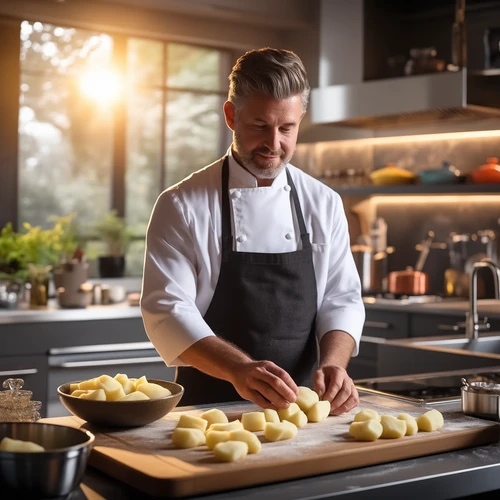Potatoes are one of the world's most beloved staples. Their versatility, comforting texture, and rich nutritional profile make them a go-to ingredient for countless dishes—from savory mains to delightful side dishes. In this guide, we'll explore the art of cooking with potatoes, focusing on a classic recipe, essential techniques, and creative twists to elevate everyday meals.
First, let’s introduce the star of the show: a timeless recipe that showcases potatoes in their most beloved form— Potato Gnocchi. These pillowy dumplings, lightly crisped and served in your favorite sauce, exemplify how simple ingredients can create a gourmet experience.
Ingredients (for 4 servings):
- Potatoes – 800g
- All‑purpose flour – 150g
- Egg – 1 whole (approx. 50g)
- Salt – 10g
- Black pepper – 2g
- Olive oil – 20g
- Fresh parsley (optional garnish) – 5g
Step‑by‑step instructions:
- Preheat the oven to 200 °C. Place the potatoes on a baking sheet, drizzle with a little olive oil, and season lightly with salt and pepper. Roast for 45–50 minutes, turning once, until the skins are crisp and the flesh is tender.
- Remove the potatoes from the oven and let them cool just enough to handle. Poke each potato several times with a fork, then break it into chunks. While still warm, rub the potatoes between your palms to form smooth skins. This gentle squeezing releases steam and removes excess moisture.
- Transfer the warm potatoes to a clean work surface. Sprinkle the flour over the potatoes, add the egg, and fold the mixture gently with a spatula. Knead the dough until it comes together into a cohesive, slightly sticky ball. If the dough remains too wet, add a teaspoon of flour at a time until it holds together but is not stiff.
- Divide the dough into 6–8 equal portions. Roll each portion into a long rope, about 2 cm thick. Cut the ropes into bite‑size segments, then press each piece lightly against the tines of a fork to create the classic ridges that help sauce cling.
- Bring a large pot of salted water to a rolling boil. Add the gnocchi in batches, avoiding overcrowding. When the gnocchi float to the surface after about 2–3 minutes, let them simmer for an additional 30 seconds, then transfer them to a slotted spoon.
- Meanwhile, whisk a simple sauce: combine 50g of butter, 2 minced garlic cloves, a pinch of crushed red pepper, salt, and pepper. Add 100g of grated Parmesan, a splash of cream if desired, and a drizzle of lemon juice. Toss the cooked gnocchi in the sauce until evenly coated. Plate, garnish with chopped parsley, and serve immediately.
Beyond the gnocchi recipe, here are a handful of pro tips for working with potatoes:
- Choose the right variety: Russet potatoes give the best fluffiness; Yukon Gold adds buttery flavor; fingerlings are excellent for roasting whole.
- Handle moisture: Moist potatoes produce soggy cakes or gnocchi. Always cool cooked potatoes slightly and dry them gently before working.
- Enhance flavor: Add minced garlic, rosemary, or grated Parmesan to mash for an extra punch. For sweet, incorporate a sprinkle of sugar or brown butter.
- Use potato skins: Cleaned skins are crunchy and nutritious when roasted—they’re perfect in salads or as a snack with dip.
- Store wisely: Cooked potatoes keep best refrigerated in airtight containers, but fresh potatoes should remain in a cool, dark place to prevent sprouting.
With these techniques and the classic gnocchi recipe, you can transform humble tubers into show‑stopper dishes that delight the palate and warm the heart. Experiment with different sauces—such as creamy sage or spicy arrabbiata—and let your creativity run wild. Bon appétit!


